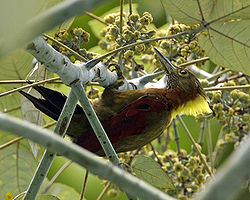| Chrysophlegma | |
|---|---|
| | |
| Scientific classification | |
| Kingdom: | Animalia |
| Phylum: | Chordata |
| Class: | Aves |
| Order: | Piciformes |
| Family: | Picidae |
| Tribe: | Picini |
| Genus: | Chrysophlegma Gould, 1850 |
| Type species | |
| Picus flavinucha [1] Gould, 1834 | |
| Species | |
See text | |
Chrysophlegma is a genus of birds in the woodpeckers family Picidae. These species, found in South and Southeast Asia, were all previously assigned to the genus Picus .










